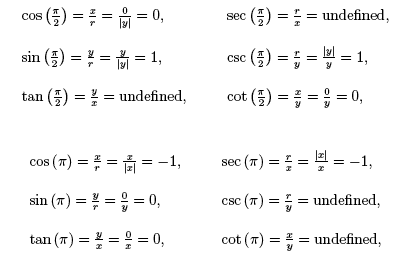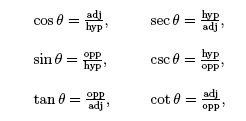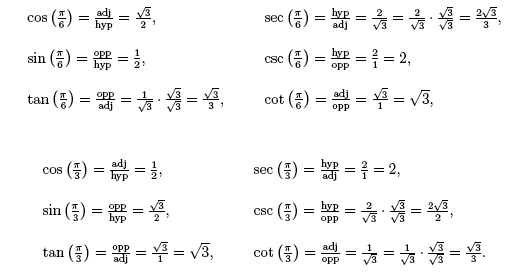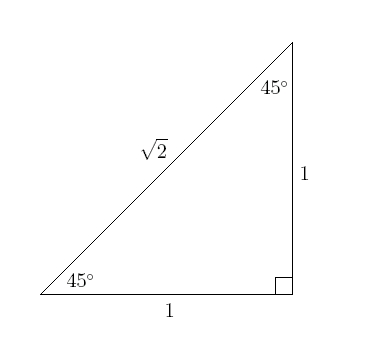Trigonometric Functions
Some Special Angles
|
Quadrantal Angles Up until now we have found the trigonometric functional value of some angle in standard position given some point (x, y) on the terminal ray. Now we will find the trigonometric functional values for some special angles.We will begin with the quadrantal angles.
Examples of quadrantal angles include, 0, π/2 , π , and 3π/ 2. Angles coterminal with these angles are, of course, also quadrantal. We are interested in finding the six trigonometric functional values of these special angles, and we will begin with θ = 0. Since any point (x, y) on the terminal ray of an angle with measure 0 has y coordinate equal to 0, we know that r = |x|, and we have,
Using a similar approach, we can find the six trigonometric functional values for
The trigonometric functional values of angles coterminal with 0, π/2 , π, and 3π/2 are the same as those above, and the trigonometric functional values repeat themselves (e.g., π and 3π are coterminal and sin (π) = sin (π + 2π) = sin (3π) = 0). This illustrates the fact that the trigonometric functions are periodic. We will discuss this in greater detail in the next section. Right Triangles To find the trigonometric functional values of other special angles, we will redefine the six trigonometric functions relative to an angle of a right triangle. Consider the following right triangle,
We can find the trigonometric functional values using the following definitions:
where adj, opp, and hyp are short for side adjacent to θ, side opposite θ , and hypotenuse, respectively. You should be convinced that these new definitions are consistent with the previous ones. Now consider the following 30° - 60° - 90° triangle:
It may be helpful to recall the Pythagorean Theorem, a2 + b2 = c2, where a and b are the legs of a right triangle, and c is the hypotenuse. Using the above definitions of the trigonometric functions, we can compute the trigonometric functional values of θ = π/ 6 (30° ) and θ = π/ 3 (60°) as,
We will now find the trigonometric functional values of another special angle, the 45°-45°-90° triangle, as depicted in the following figure: Using the above triangle we find the six trigonometric functional values of θ = π/ 4 (i.e. 45°) as, Other Special Angles We can also find the exact trigonometric functional values of a few other angles that relate to the angles θ = π/6, θ = π/4, and θ = π/3 in certain ways. To look at these other angles, we introduce the concept of a reference angle, denotated as θ'. To compute the reference angle for an angle that has negative measure, find the first positive coterminal angle. To find the reference angle for an angle that is larger than 360° , find a coterminal angle that lies between 0° and 360°. Once you have an angle θ with 0° ≤ θ ≤ 360°, you can find its reference angle as follows:
The reference angle is used to find the exact trigonometric functional values of angles that terminate outside of the first quadrant. In particular, it is true that | trig ( θ ) | = trig ( θ' ), where trig denotes one of the six trigonometric functions. For example, suppose we want to find sin (7π/6) . First, convert 7π/6 radians to degrees since we have more intuition about degree measure. Since 7π/6 radians is the same as 210° , we are trying to find sin (210°), where θ = 210° is located in quadrant III. Thus, θ' = 210° −180° = 30° , where θ' is the reference angle (a special angle). Since sin (30°) =sin (π/6) = 1/ 2 , we know that sin (210°) = sin(7π/6) is either equal to 1/2 or −1/2 . To determine which one, we ask ourselves, is the sine function positive or negative in quadrant III? To answer this question, we recall the definition of sin θ, sin θ = y/r . Since the y-coordinate of a point in quadrant III is negative, and r is defined to be positive, sin θ (where θ lies in quadrant III) must be negative. Therefore, we conclude that,
***** In the next section we will explore the graphs of trigonometric functions. |
The Biology Project > Biomath > Trigonometric Functions > Special Angles
Department of Biochemistry and Molecular Biophysics
The University of Arizona
April 2006
Contact the Development Team
http://www.biology.arizona.edu All contents copyright © 2006. All rights reserved.










